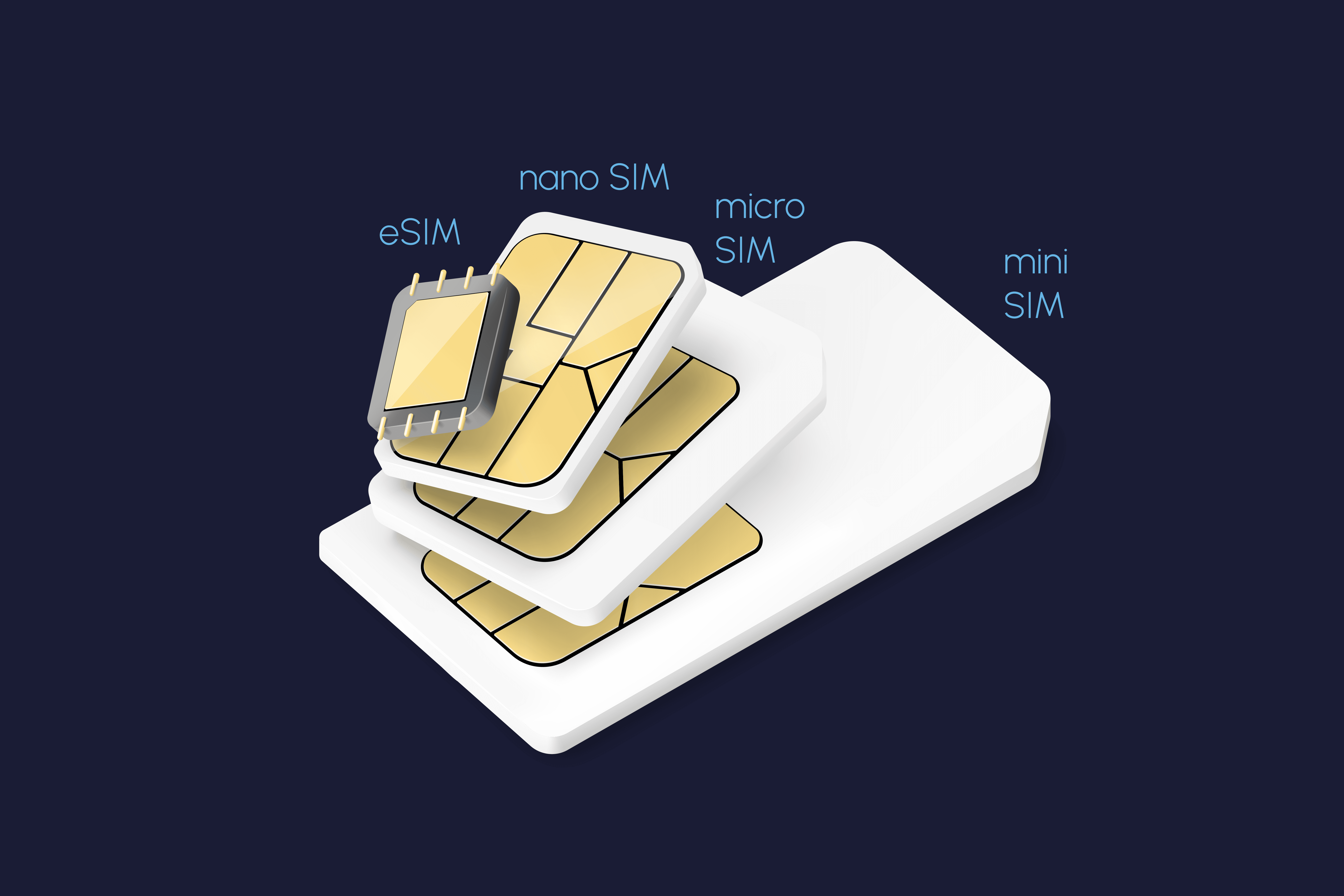eSIM
Erfahren Sie in 8 Fragen mehr über eSIMs
Lassen Sie sich nicht einschüchtern, es ist nicht so kompliziert!
Sie kennen sich mit eSIMs noch nicht aus und möchten sich vor dem Wechsel schnell damit vertraut machen? In diesem Blog erkunden wir die Grundlagen von eSIMs und erfahren mehr über ihre Funktionsweise und Verwendung, indem wir 8 häufige Fragen beantworten, die Sie möglicherweise haben.

1. Was ist eSIM?
eSIM ist die Abkürzung für Embedded SIM, und ist eine virtuelle SIM-Karte, die in Ihr Gerät eingebettet ist. Im Gegensatz zu den herkömmlichen, physischen SIM-Karten sind eSIMs kleine Chips, die Teil der Schaltkreise des Geräts sind und nicht aus dem Gerät entfernt werden können.
Um eine eSIM zu verwenden, müssen Sie sie nicht einfach in Ihr Gerät „einlegen“, sondern ein eSIM-Profil herunterladen – das allgemein alsInstallieren einer eSIMDies ist vergleichbar mit der Installation einer Software.
Durch das Herunterladen eines eSIM-Profils werden im Wesentlichen die erforderlichen SIM-Informationen auf Ihr Gerät heruntergeladen, um die Herstellung der Verbindung mit Ihrem Netzwerk zu erleichtern.
2. Was benötige ich, um eine eSIM nutzen zu können?
Alles was Sie wirklich brauchen ist eineSIM-kompatibles Gerät.
Sie müssen außerdem sicherstellen, dass Ihr Mobilfunkanbieter eSIM-Unterstützung für das von Ihnen verwendete Gerät bietet. Sie benötigen ein eSIM-Profil bei Ihrem Mobilfunkanbieter, das Sie herunterladen und installieren können, um eine Verbindung zum Netzwerk herzustellen.
Einige Produkte behaupten, eSIM-Kompatibilität auch auf nicht-eSIM-kompatiblen Geräten zu bieten. Beachten Sie jedoch, dass diese Produkte möglicherweise nicht mit allen Netzbetreibern und Anbietern funktionieren.
3. Benötige ich eine physische SIM, um eine eSIM zu verwenden?
Nein, das tust du nicht!
eSIMs funktionieren genau wie physische SIM-Karten, und es ist technisch möglich, dass Sie eine eSIM verwenden, auch wenn Sie keine physische SIM-Karte in Ihrem Gerät haben. Tatsächlich gibt es einige Geräte, die nur eSIMs unterstützen, was bedeutet, dass Sie auf Ihrem Gerät nur eSIMs verwenden können.
Beachten Sie jedoch, dass Ihr Gerät zwar eSIMs ohne physische SIM-Karte unterstützt, Ihr Mobilfunkanbieter jedoch möglicherweise verlangt, dass Sie sich zunächst eine physische SIM-Karte besorgen, bevor Sie auf eine eSIM umsteigen können. Dies hängt vollständig vom Mobilfunkanbieter ab. Prüfen Sie daher am besten die Anforderungen Ihres Mobilfunkanbieters.
Sie benötigen außerdem eine stabile Internetverbindung, um Ihr eSIM-Profil zu installieren. Dies kann jedoch auch einfach durch eine Verbindung mit einem WLAN-Netzwerk erreicht werden.
4. Welche Vor- und Nachteile bietet die Nutzung einer eSIM?
eSIMs sindam bekanntesten für den Komfort, den es bietet, insbesondere auf ReisenSie können Ihre eSIMs schnell installieren und aktivieren, ohne mit physischen SIMs herumhantieren zu müssen.
Der Nachteil ist jedoch, dassEs ist möglicherweise nicht einfach, Ihre eSIMs zwischen Geräten zu übertragenwenn Sie das Gerät wechseln möchten. Das Einrichten von eSIMs für Postpaid-Anschlüsse kann auch etwas problematischer sein, je nachdem, wie Ihr Mobilfunkanbieter eSIMs bereitstellt.
Abgesehen davon funktionieren eSIMs ähnlich wie physische SIM-Karten. Wenn Ihre Hauptsorgen Geschwindigkeit, Stabilität oder Sicherheit sind, können Sie sicher sein, dass eSIMs im Vergleich zu physischen SIMs grundsätzlich keine Vor- oder Nachteile haben.
5. Kann ich mehrere eSIMs gleichzeitig verwenden?
Das hängt von Ihrem Gerät ab!
Einige Geräte (wie iPhones) ermöglichen die Verwendung von zwei eSIMs, während bei anderen (wie der Samsung Galaxy-Serie) immer nur eine aktive eSIM gleichzeitig möglich ist.
Auf den meisten Geräten können Sie jedoch mehrere eSIMs gleichzeitig installieren. Das bedeutet, dass Sie mehrere eSIM-Profile auf Ihr Telefon herunterladen und speichern können und mit wenigen Fingertipps auf Ihrem Gerät einfach zwischen ihnen wechseln können.
6. Kann ich mit einer eSIM telefonieren und Nachrichten senden?
eSIMs haben ähnliche Funktionen wie SIM-Karten. Mit der eSIM-Technologie selbst können Sie Anrufe tätigen und Nachrichten senden/empfangen.
Ob Sie jedoch letztendlich Anrufe tätigen und Nachrichten senden können,hängt vom Telefontarif abdie Sie haben. Wenn Ihr Tarif das Telefonieren und Senden/Empfangen von Nachrichten erlaubt, können Sie dies auch mit einer eSIM tun.
Wenn Ihr Tarif nur Daten enthält, können Sie keine Anrufe tätigen und keine Nachrichten über das Mobiltelefon senden/empfangen. Aber selbst dann können Sie weiterhin VoIP-Anrufe über das Internet tätigen oder soziale und Messaging-Apps nutzen, um anzurufen oder Nachrichten zu senden!
7. Sind eSIMs teurer als physische SIMs?
Nein, sind sie nicht.
eSIMs sind normalerweise nicht teurer als physische SIMs. Wie viel Sie bezahlen, hängt bei den meisten Anbietern in erster Linie von dem gewählten Tarif ab und nicht von der SIM-Option. Für denselben Tarif sind die Preise normalerweise gleich, egal ob Sie sich für eine physische SIM-Option oder eine eSIM-Option entscheiden.
Beachten Sie jedoch, dass Mobilfunkanbieter möglicherweise nicht für alle Tarife eSIM-Optionen anbieten. Fragen Sie bei Ihrem Mobilfunkanbieter nach, ob der gewünschte Tarif auch eine eSIM-Option bietet!
8. Kann ich eine eSIM entfernen?
Sie können den eSIM-Chip nicht einfach entfernen, aber Sie könnenLöschen Sie Ihr eSIM-Profil.
Bitte beachten Sie, dass eine Wiederherstellung Ihres gelöschten eSIM-Profils nicht immer möglich ist. Stellen Sie daher sicher, dass Sie Ihr eSIM-Profil nur dann löschen, wenn Sie sicher sind, dass Sie es nicht mehr benötigen!
Holen Sie sich eine Nomad eSIM für Ihre nächste Reise
Sind Sie bereit, auf eSIMs umzusteigen oder möchten Sie es bei Ihrer nächsten Reise ausprobieren? Holen Sie sich eine Nomad-Reise-eSIM!
NomadeAngeboteDatentarife in über 170 Ländern, und Sie können sicher sein, dass Sie eines finden, das Ihren Reisebedürfnissen entspricht. Und wenn Sie durch mehrere Länder reisen, gibt es auchRegionalpläneverfügbar, sodass Sie auch unterwegs zwischen den Ländern nahtlos verbunden bleiben können. Datentarife sind bereits ab 1,50 $/GB erhältlich.
Wenn Sie unsicher sind überwie viele Daten du für deine Reise benötigst, Nomad hat auch eine**Datenrechner**das kann Ihnen helfen, den für Sie am besten geeigneten Plan zu finden. Lesen Sie auch unseren Blog-Beitrag überDatenspartipps für unterwegsum Ihren Datenverbrauch auf Reisen unter Kontrolle zu halten.